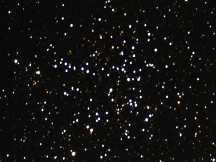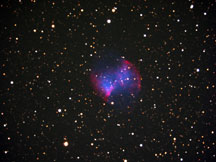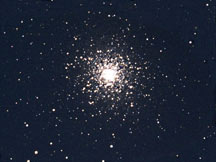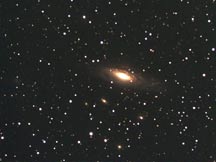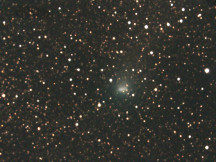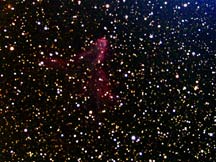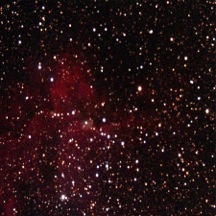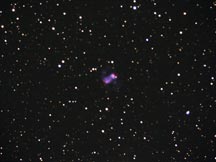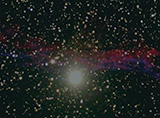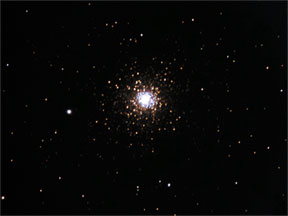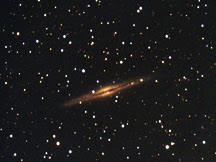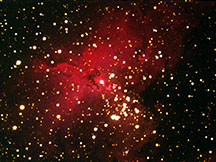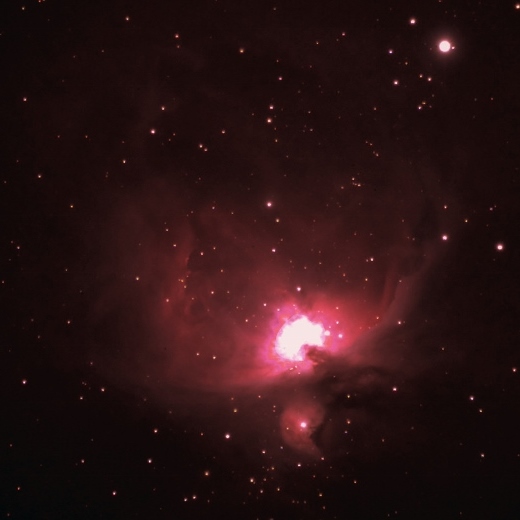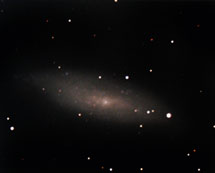
Jessica Sherman photo taken with Rick Nolthenius of The North Bear Nebula, Catalog # IC1795 in the Cassiopeia constellation. 3 5-minute exposure photos were taken starting at 9:55pm on September 30, 2014 using the 12 inch telescope and st 2000 xcm. Taken at the Cabrillo Observatory Dome, chip temperature was -20 degrees on a clear night with a bright crescent moon, there were no clouds throughout the night.
With CCDOPS on each picture I Dark Subtracted DKS5-20 then flat fielded with f.oct30 and finally color processed it with SRGB + Gamma and saved each picture.
Registax: Version 6 was used to align all 3 photos at once using the brightest center star and then stacked the photos together and saved the photo.
I placed the stacked photo in Photoshop where I adjusted saturation and curves to help darken my background and brighten my color.
|
IC63, emission nebula. Michelle Castagnetto, 12" telescope, ST 2000 XCM camera, 9:22 PM on November 25th 2014 at the Cabrillo Observatory. 65'above horizon. -30 degrees celsius. No moon, clear and cold night.CCDOPS dark subtract, flat field,color process sRGB+gamma. Registax 3 frame stack.Photoshop CS6 levels, curves, saturation +3, make stars smaller, reduce space noise, image rotate 180 degrees,resize for gallery
|
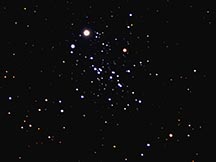
Sean Schlaefli
Astro 8A
Fall 2014
NGC 457 also known as the Owl cluster, ET cluster, or Caldwell 13.
Two five minute exposures were taken with the ST2000 camera. Both
images were dark frame corrected and colorized using the sRGB with gamma
method. The images were then stacked using RegiStax 5.1 and edited in Photoshop. The
first thing I did was crop the image and rotate it 180 degrees. Following this, I adjusted
the curves and levels to change the brightness. I adjusted the saturation to intensify the
color in my image and applied the unsharp mask and the despeckle filters to improve my image.
|
no thumbnail
Adrian Jimenez "Orion Nebula" Catalog # M-42 taken by Rick Nolthenius on 11/25/14 at 10 pm using the 12 ich telescope taken at the Cabrillo observatory. Chip temp -30 Sky conditions minimal light pollution, no moon, fairly humid and toe freezing. steps in ccd opts.. Dark subtracted DKS5 -30 Flat field Foct30-3 Color processed SRGB+gamma stacked in right stacks Photo shop i adjusted the saturation, contrast, vibrance levels and curves.
|
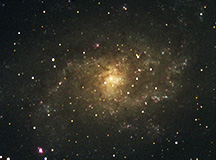
M33
3 images were taken with the st2000xcm 12" telescope on 8/28/2014 starting at @ 8:30. Sky conditions were clear, medium/small crescent moon ~100 degrees west of the telescope direction. Cold night with some fallen dew on the lens. While taken the pictures the Y axis wandered significantly more than the X axis (for each photo). In CCDOps, the dark frame used was dk5-23.ST2K, and flat-field was fOct30-3.ST2K. Color processed with SRGB + Gamma, and stacked in Registax using a star in the upper left field as the stacking point. Taken into Photoshop, first thing I noticed was RGB speckles all over the image. I tried despeckling, but that didn't work, so I used Healing Brush(?) to re-color them to a more correct color. Used the levels and curves to make bright things brighter, and dark things darker. I brought the saturation up to ~+5. Using the astronomy tools uploaded onto the PC, I made the stars smaller, reduced the noise, and sharpened deep space objects (M33 itself). Upon outside input, I again made bright brighter, and dark darker, losing the "visible" star in the center, but gaining better view of the arms. The image still seemed grainy, but any further actions seemed to either not change anything, or make it worse, but the grainy-ness didn't seem to detracting from the image itself.
|
